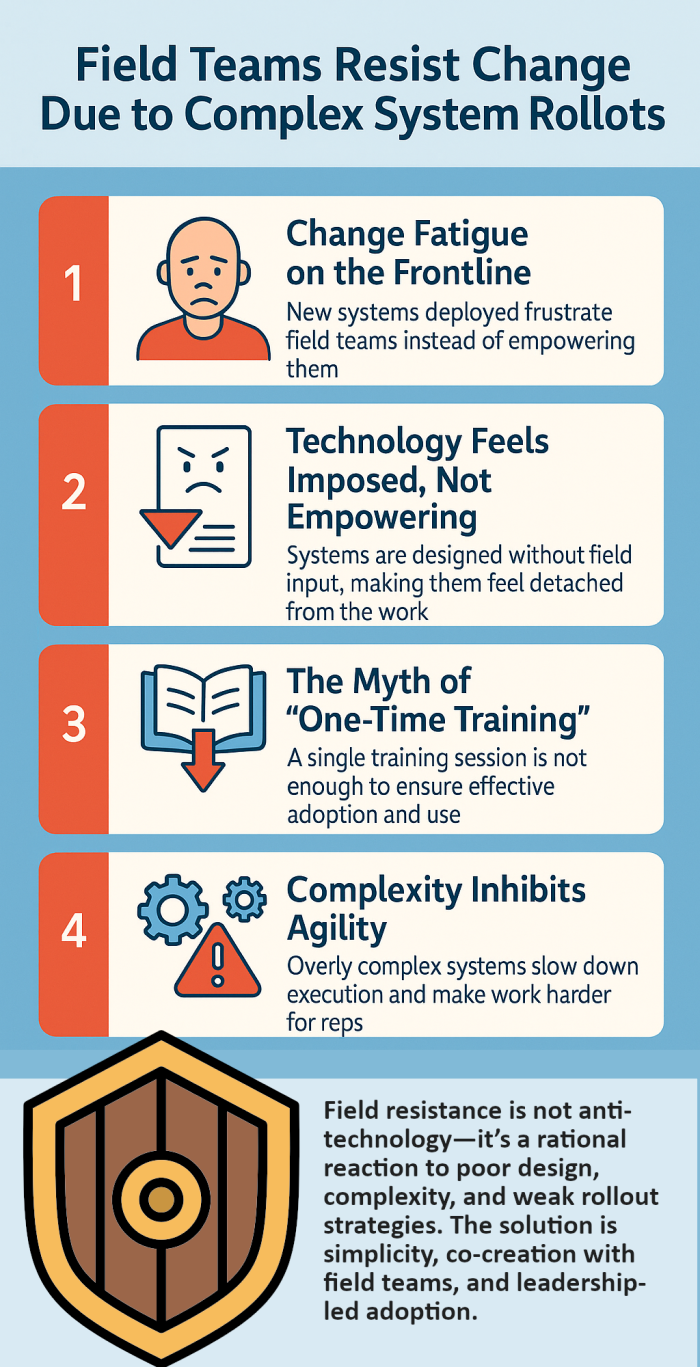Change Fatigue on the Frontline
In the pursuit of digital transformation in FMCG supply chains, many companies across FMCG, Pharmacy, and Tobacco industries deploy new systems with the goal of improving field operations. Yet, instead of excitement, the most common reaction among field teams is frustration—or worse, silent resistance. The core reason? Rollouts that are overly complex, poorly communicated, and not aligned with the day-to-day reality of sales and distribution work.
When systems are introduced without understanding the operational flow of the field, even small updates become burdensome. New apps, dashboards, or approval procedures may be intended to help, but to a field rep navigating retail negotiations, route pressures, and time targets, these “improvements” often feel like additional work layered on top of their existing load.
Technology That Feels Imposed, Not Empowering
Most resistance stems not from an aversion to technology itself, but from the way it’s introduced. Too often, platforms are built by central teams—with limited input from field users—then handed down with minimal training or context. This top-down approach creates a sense of detachment. Field users feel like they’re being told what to do by people who don’t understand their job.
Moreover, the lack of field involvement leads to workflows that feel counterintuitive. Processes that used to take minutes are replaced by multi-step procedures, requiring logins, approvals, and validations in systems that weren’t designed for on-the-go environments. What was promised as simplification becomes complexity—and adoption suffers as a result. For more insights, see McKinsey on the tech transformation imperative in retail.
The Myth of "One-Time Training"
Another major pitfall in system rollouts is the assumption that a one-time training session is enough. Field teams are expected to grasp new features, adapt to new processes, and deliver results immediately after a two-hour session or a PDF manual. In reality, behavior change takes time, reinforcement, and contextual coaching.
Without continuous support, adoption rates decline rapidly after launch. Features are underutilized, data becomes incomplete or inaccurate, and the system fails to produce the intended business value. Eventually, management concludes that the field isn’t “ready for change,” when the real issue lies in how the change was delivered.
Complexity Inhibits Agility
When systems are too complex, they slow down the very agility they were meant to enable. Field reps hesitate to engage with platforms that are hard to navigate or full of unclear logic. As a result, reporting gets delayed, workflows are bypassed, and data integrity is compromised.
Instead of enabling faster execution, companies end up creating digital friction. The field spends more time on system inputs than customer conversations, and frontline effectiveness declines. Worse, valuable insights from the field never make it back to headquarters—because they were never captured in the first place.
Field Teams Need Tools That Think Like They Do
Frontline workers don’t need more features—they need fewer steps. Systems must be intuitive, mobile-first, and aligned with how field reps actually operate. This means offline capability, minimal data entry, automated tracking, and workflows that respond to real-world behavior—not rigid back-office logic.
Digital tools should feel like enablers, not enforcers. When reps see how a system helps them close more deals, earn incentives faster, or reduce manual work, adoption happens organically. But this can only occur if platforms are designed with empathy and co-created with the field—not built in silos. See also McKinsey on the real value of digital and AI transformation in CPG.

Trust Is Built Through Small Wins
The field doesn’t trust promises—they trust experience. A successful rollout is not about launching a big system; it’s about delivering small, repeatable wins. A faster order entry screen, a smarter visit planner, or instant stock visibility—these are the changes that build belief in the system. Guidance can be found in McKinsey’s framework on outperforming with digital and AI in CPG.
When reps experience firsthand how a tool makes their job easier, they begin to adopt more features. Change scales when it’s anchored in utility. Companies must resist the urge to “launch everything at once” and instead adopt a phased, feedback-driven approach. This aligns with strategies on supply chain resilience through digital transformation.
Leadership Must Model Adoption
Adoption starts at the top. If regional managers and supervisors continue using legacy tools while asking reps to use the new system, resistance becomes rational. But when leadership uses the new dashboards, bases reviews on live KPIs, and recognizes reps for digital compliance, a culture of change begins to take root.
Change is contagious—but so is resistance. Field teams take cues from the behavior of their direct managers. Organizations that align leadership behavior with system goals see far greater adoption and engagement at every level.
Conclusion: Simplicity is the Ultimate Adoption Strategy
Field resistance is not a rejection of digital—it’s a response to poor design and rollout. Companies must stop pushing complexity in the name of transformation. Instead, they should build tools that align with real-world workflows, roll them out with support, and celebrate small wins that build long-term trust.
Transformation happens when the field feels empowered—not overwhelmed.
